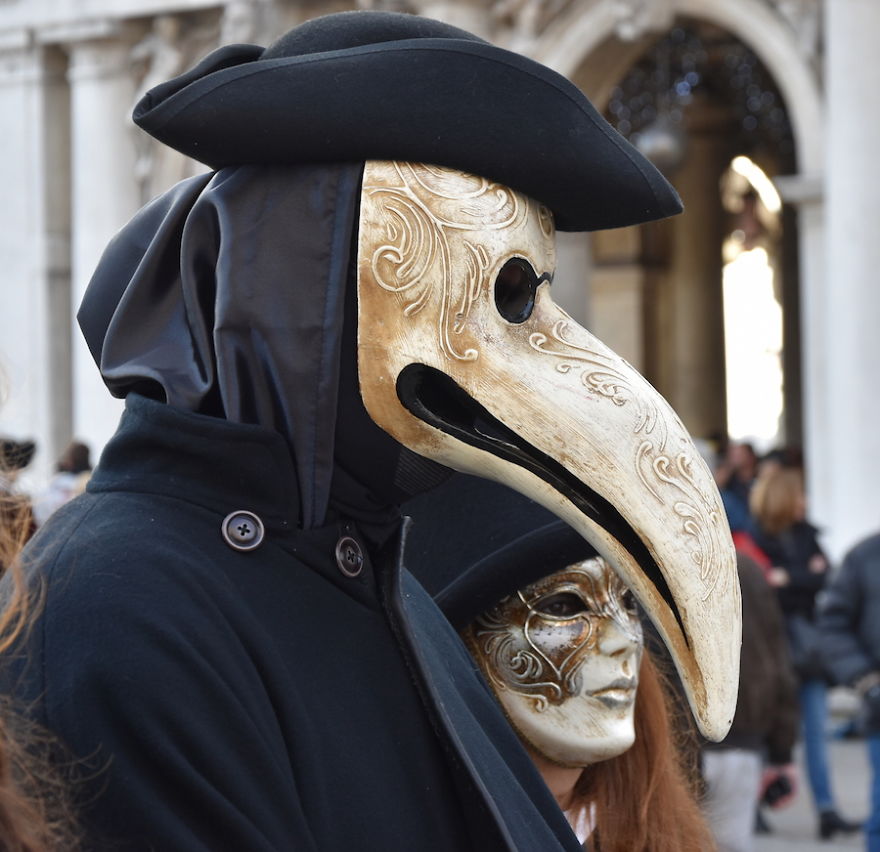By Tim Gihring //
Don’t be surprised if the most popular image to emerge from “Martin Luther: Art and the Reformation,” Mia’s comprehensive look at the objects and art behind Luther’s 16th-century revolt against the Catholic Church, is not of the pulpit from which he preached his last sermons, or the life-size model of his home, or even his beer mug. It may well be this hood, encased in a corner of the exhibition’s opening gallery like a strange and terrifying bird.

Paul Fürst’s satirical engraving of a plague doctor dates to the 1600s and includes a poem suggesting the doctors were in it for the money.
It is a plague doctor’s hood, from the Deutsches Historisches Museum in Berlin, and was worn in the 1600s by whoever was desperate or brave enough to treat victims of the deadly epidemic. They wore the hood along with a hat, robe, gloves, and breeches as a kind of early bio-hazard suit, and used a stick to touch the sick. The plague was thought, like all disease, to be spread through “miasma,” the unpleasant air of decay and evil, so the doctors stuffed the beak-like nose of their hood with pleasant-smelling spices and other substances—perhaps ambergris, rose petals, camphor, or straw—that they believed would ward off the deadly vapors. The crystal eyepieces—goggles in other versions—were generally colored red to counter the evil eye, according to some accounts, though they aren’t in this hood.
If the affect of a queer, Hieronymus Bosch-like bird is more than mere coincidence, the superstition has been lost to time. The doctors may have believed that birds were transmitting the plague, and the disease would transfer from the afflicted to the costume, which could be harmlessly destroyed. Or the opposite may be true, that birds were considered protective—children were supposedly encouraged to keep birds as good-luck charms. No one knows.
Most of the so-called plague doctors were not medical professionals. The regular bloodletters fled town whenever episodes of the plague broke out, along with anyone else healthy and wealthy enough to skedaddle. The plague doctors were mercenaries—well paid, by all accounts—who attended the dead and the dying, and many of them died or fled, too. During the first big outbreak of the plague in Europe, beginning in 1346, there were reportedly 18 plague doctors in Venice. Two years in, only one was left—five had died of the plague, 12 had made themselves scarce.
You may have seen something like this outfit at Mardi Gras, or the Venice Carnival, where it’s known as the medico della peste mask. Lately, the look has taken off in steampunk circles, as protoscience and perhaps because goggles. The outfit even turned up in a recent circular about plague among animal species, distributed by the U.S. Geological Survey.
In Luther’s time, there was nothing fun about a plague doctor. Two of his brothers died of the plague, as did two of his professors. Some of the objects in Mia’s Luther show were found in so-called plague pits, where Luther’s family disposed of anything thought to be infected with disease.
In 1527, 10 years after Luther came out with his 95 theses against the sale of indulgences and sparked the Reformation, the plague raged in his home city of Wittenberg. Many students and instructors at the University of Wittenberg, where Luther worked at translating and teaching the Bible, left town. But he stayed. In fact, he took in the sick.
His rationale was spiritual, not medical. He worked through his thinking in a tract released that year, called “Whether One May Flee from a Deadly Plague.” It was not an easy question. For centuries it was thought that the plague was God’s divine and deserved punishment—believers should not try to escape it. (Some victims even asked to be flogged, thinking God would see their contrition and spare them.) Luther wasn’t so sure. “I cannot tell if the plague will allow me to finish [translating] the Epistle to the Galatians,” he wrote to a friend. “Rapid and sudden, it is making great ravages, especially among the young. You advise me to fly. Whither shall I fly?”
To save one’s God-given life, he eventually decided, was not a sin—indeed the sin would be to reject the intelligence God had granted. If the situation worsened, he would send his followers away. But he thought that anyone in a position of power, or a position to help, should stay—including himself. “My place is here,” he wrote, “obedience will not permit my flight, till He who has called me recalls me. Not that I do not fear death (for I am not the apostle Paul, I am only his commentator), but I hope that the Lord will deliver me from fear.”


